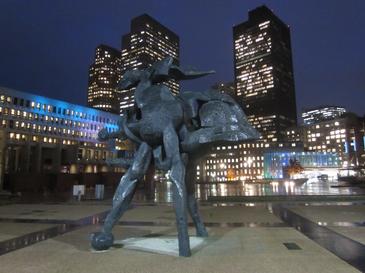Thermopylae (Hadzi) facts for kids
Quick facts for kids Thermopylae |
|
|---|---|

The sculpture at night in 2019
|
|
| Artist | Dimitri Hadzi |
| Year | 1966 |
| Medium | Bronze sculpture |
| Location | Boston, Massachusetts, U.S. |
Thermopylae is a large bronze sculpture created in 1966 by Dimitri Hadzi. You can find it in Boston, Massachusetts, U.S.A., at the Boston City Hall Plaza. It's located near the John F. Kennedy Federal Building in an area called Government Center.
Contents
About the Thermopylae Sculpture
What the Sculpture Looks Like
This sculpture is an abstract piece of art. This means it doesn't show a real person or object exactly as it looks. Instead, it uses shapes and forms to express ideas or feelings.
The Thermopylae sculpture is about 12 feet tall and 16 feet wide. That's like two basketball hoops stacked on top of each other! It's also very heavy, weighing 2.5 tons. That's as much as a small truck.
Why the Sculpture Was Made
The sculpture was ordered by the General Services Administration, which is a U.S. government agency. It was made to honor John F. Kennedy, who was a U.S. President.
A special plaque near the sculpture explains its meaning. It says the sculpture was inspired by President Kennedy's book, "Profiles in Courage." This book tells stories of brave Americans. The sculpture also honors President Kennedy's amazing record during World War II.
The Meaning Behind the Name
The sculpture is named "Thermopylae" after a famous ancient Greek battle. In this battle, a small group of brave Spartan soldiers fought against a much larger Persian army. They fought with incredible courage until the very end. The name "Thermopylae" connects the sculpture to this idea of great bravery and sacrifice.
How the Sculpture is Designed
The plaque also describes the sculpture's design. It says the shapes are "symbolic" and "organic." This means they represent ideas and look like natural forms, even though they are abstract.
The artist, Dimitri Hadzi, used different types of shapes to create interesting contrasts. You'll see heavy forms next to thin ones. There are solid parts and open spaces. Some parts go up and down (vertical), while others go side to side (horizontal). You can also spot round shapes next to sharp, angular ones.
The sculpture changes how it looks depending on the weather. Sunlight, rain, and snow make it appear different. This gives people who see it new visual and emotional experiences each time.
Keeping Art Safe
In 1997, the sculpture was checked by a program called "Save Outdoor Sculpture!" This program helps to keep outdoor artworks like Thermopylae safe and in good condition for everyone to enjoy.

